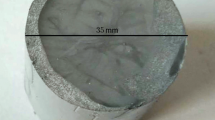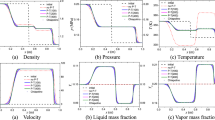Abstract
The detonation of underwater explosives is a complex problem involving a temporally dependent heterogeneous reaction regime of oxidizer reactions and high pressure metal combustion. For simplicity, underwater explosions may be described as a two stage reaction process. First, the oxidizing material detonates to produce species under extreme conditions of temperature (up to 5000 K) and pressure (up to 10 GPa). The chemical energy produced from this reaction is transferred to the bulk water as three forms of work: (1) shock, (2) heat, and (3) initial bubble formation. Second, the species produced by the oxidizer detonation form a high pressure and high temperature reactive fluid that surrounds the solid particles. The solid particles are primarily consumed while the pressure is decreasing from 10 GPa to 0.1 GPa at a reaction temperature in excess of 3200 K. The secondary reaction of the solid particles produces a lower energy shock and a pressure response that reinforces the initial energy delivered to the bulk water medium. The ability to tailor this late energy release between shock and bubble formation is dependent on the reaction time and chemistry of the solid particle under extreme conditions. We present a series of single-shot time resolved emission experiments that probe the reaction of aluminum particles under extreme conditions. The temporal behavior of the observed species is used to gain insight into the chemical reaction mechanism that leads to the formation of Al2O3 during underwater detonations.
Similar content being viewed by others
References
Brzustowski T. A. and Glassman I., Heterogeneous Combustion, Progress in Astronautics and Aeronautics Series, 15, Wolfhard, I, Glassman, I, Green, L. eds., New York, Academic Press, 1965, pp. 41–73.
Driscoll J.F., Nicholls J.A., Patel V., Shahidi B.K., and Liu T.C., AIAA Journal, 1985, pp. 856–858.
Jones M. R., and Brewster M. Q., J. Quant. Spectroc. Radiât. Transfer, 46, pp. 109–118, 1991.
Russell T. P., Allen T. M., Rice J. K., and Gupta Y. M., J. Physique (in press).
Russell T. P., Allen T. M., and Gupta Y. M., Chem. Phys. Lett, (submitted).
Merrill L. and Bassett W. A., Rev. Sci. Instr., 45, pp. 290–294 (1983).
Russell, T. P. and Piermarini, G. J., (manuscript in preparation).
Block S. and Piermarini G. J., Phys. Today, 29, 44–55 (1976).
Piermarini G. J., Block S., Barnett J. D., and Forman R. A., J. Appl. Phys., 46, pp. 2774–2780 (1975).
Brown, C.A. and Russell, T.P., manuscripts in preparation.
Carlson D.W., Deiter J.S., Doherty R.M., and Wilmot G., Proceedings Tenth Symposium (International) on Detonation Boston MA 1994.
Acknowledgments
The research was conducted with support from the Office of Naval Research and the Naval Research Laboratory. C. A. Brown is an NRL/NRC post-doctoral fellow. Some experiments were conducted in the laboratory of Y. M. Gupta at the Shock Dynamics Center in the Physics Department of Washington State University with the aid of T. M. Allen and G. Pangilinan and with the support of ONR.
Author information
Authors and Affiliations
Rights and permissions
About this article
Cite this article
Brown, C.A., Russell, T.P. Time Resolved Emission Studies of Aluminum and Water High Pressure Reactions. MRS Online Proceedings Library 418, 391–395 (1995). https://doi.org/10.1557/PROC-418-391
Published:
Issue Date:
DOI: https://doi.org/10.1557/PROC-418-391




